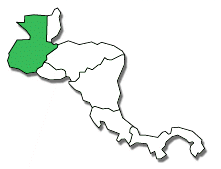|
|
 Guatemala Guatemala
This relatively small country
boasts one of the most climatically diverse regions in the
world. The soil, rainfall, humidity, altitude, and
temperature vary enough that seven distinct coffees are
produced in Guatemala. The following descriptions
were adapted from Anacafe promotional material, interviews
with Anacafe personnel, and personal experience researching
in Guatemala.
Antigua
- Antigua is internationally renowned for its high-quality
coffees. This region is located between three volcanoes
in a valley with a climate perfect for cultivating coffee.
The soils are young and optimal for coffee. Rainy
and dry seasons are definite and allow for uniform maturation.
The temperature ranges from 19-22 C (66.2-71.6°F) and the
altitude is between 4,600 and 5,600 feet. Annual rainfall
is between 800-1,200 mm and the humidity is constant at
65%. Antigua coffees are described as having a full
and velvety body, a rich and lively aroma, and a fine acidity.
Bourbon, Caturra, and Catuai are grown in this region and
harvested between January and mid-March.
Fraijanes
Plateau - The region of Fraijanes is located north
of Lake Amatitlan in the mountains surrounding the Valley
of Ermita where Guatemala City is located. The soil
is volcanic and high potassium levels lend body to the cup.
Recent volcanic activity from Volcan de Pacaya has deposited
ashes rich in minerals in this area. The altitude
where coffee is cultivated is between 4,000-5,000 feet with
moderate temperatures year round 22 C (71.6°F). The
summit of these mountains has a relative humidity of 60%
and an annual rainfall of 1,500 mm. The combination
of these factors gives a strictly hard bean (the highest
rating in Guatemala) and is similar to a genuine Antigua
coffee. These coffees are described as having a soft
aroma, full body, and a marked acidity.
Rainforest
Cobán - This zone is defined as the very humid, subtropical
forest in the northern part of the country. In fact,
the name Cobán comes from the Maya Keckchi word "cob"
which means the place of clouds. The temperature varies
depending on the winds from the North and oscillates between
15-23 C (59-73°F). The region receives between 3,000-3,500
mm of rain per year and the rain is distributed throughout
the 12 months of the year. The climate is cloudy with
few hours of sunlight and a high relative humidity (85-95%).
The soil is mostly limestone and clay. The microclimate
is created from the influence of the Atlantic Ocean.
The altitude is between 4,300 and 5,000 feet above sea level
resulting in hard and strictly hard coffees. Coffees
from Cobán have a medium body, light acidity, and fruit
like flavors. The aroma is fragrant and has light
wine notes. Bourbon, Maragogype, Catuai, Caturra,
and Pache are grown in Cobán and harvested from December
to March.
Highland
Huehuetenango - This region crosses the Cardillera
de Los Cuchamatanes with regions higher than 11,800 feet.
It is located on the border with Mexico and coffee is planted
in the regions between 5,000-6,000 feet. Rainfall
is around 1,800 mm with a relative humidity of 70-80%.
Dry and hot winds from the Tehuantepec plain in Mexico protects
the region from frost and creates its unique microclimate.
The average temperature is 23 C (73°F). The subtropical
and humid climate contributes to the beans beautiful appearance
and uniform maturation. The flowering is homogeneous
which results in a winey high-quality cup. In Huehue
Bourbon, Caturra, and Catuai are grown. Harvesting
takes place from January to April.
Atitlan
- This area encompasses all of the lands surrounding
Lake Atitlan. Coffee is mainly harvested on the side
of the Pacific in a region of three volcanic mountains with
a high precipitation. There is no month when Atitlan
will have less than 50 mm of rain. Most producers
in this region will use water from the lake for wet processing.
Instead of chemicals, organic matter is often used as a
fertilizer. The high altitude (4,000-5,900 feet) results
in a low occurrence of pests and diseases. The humidity
in this area is high hovering around 70-80%. Drying
takes place almost totally in the sun, and almost 95% of
the coffee is cultivated by small producers who have an
average of 12 hectares. The majority of coffee harvested
in this regions is Bourbon, but Typica, Caturra, and Catuai
are also grown. Harvest occurs between December and
March. Atitlan coffees are aromatic. They have
a crisp and pronounced acidity and full body.
Volcan
San Marcos - This is the warmest of Guatemala's coffee
growing regions and also has the highest rainfall.
It has the most intense rainy season and the earliest flowing
of any area. The altitude ranges from 4,600-6,000
feet with volcanic soil and a microclimate influence from
the Pacific Ocean. The annual rainfall is 4,000-5,000
mm and the humidity is between 70-80%. Bourbon, Caturra,
and Catuai are grown in this region and are harvested from
December to March.
Oriente
- The New Oriente is in the Esquipulas municipal.
Its weather is similar to Cobán, but is less intense.
It is located over a volcanic range and the soil consists
of metamorphic rock and clay. The altitude where coffee
is grown ranges from 4,300-5,500 feet, and the temperature
ranges from 18-25 C (64-77°F). This area has relatively
little rainfall compared to Cobán or San Marcos being only
1,800-2,000 mm per year. Coffees from Nuevo Oriente
are aromatic, have a marked acidity, and a good body.
Bourbon, Catuai, Caturra, and Pache are all grown in the
Nuevo Oriente region and coffees are harvested from December
to March.
Related
Links
Coffee
Origins Overview
Costa
Rican Coffee
Central
America and Mexico
Green
Coffee Defects
More
information from Anacafé:
Rainforest
Cobán
Highland
Huehues
Volcanic
San Marcos
Traditional
Atitlan
Antigua
Classic
Fraijanes
Plateau
New
Oriente
|
|
|


